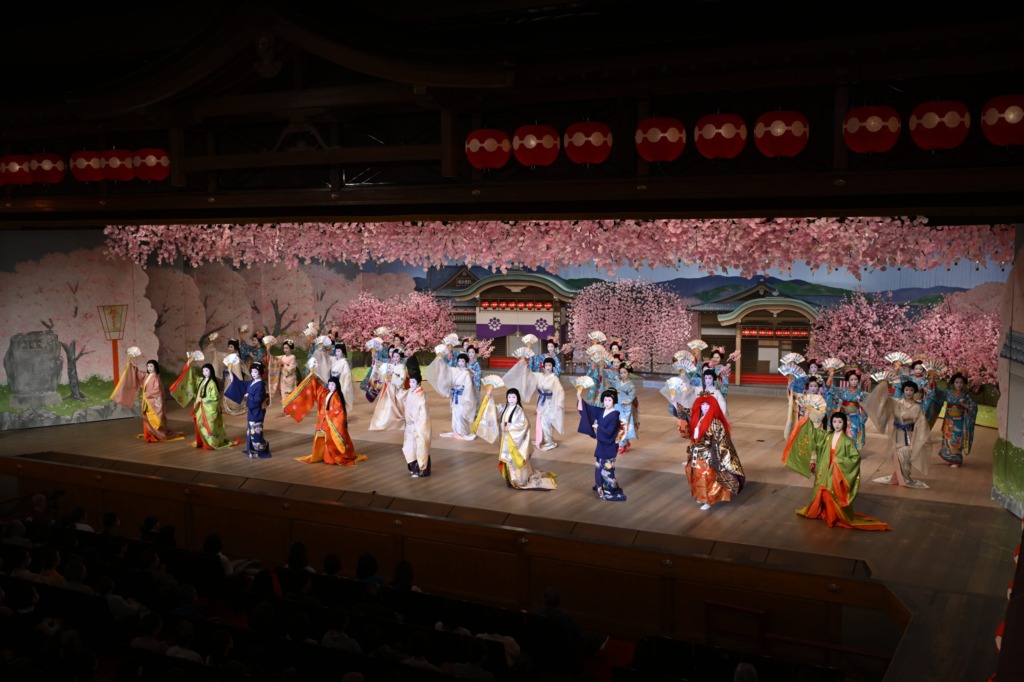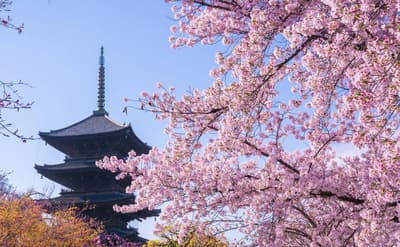If you are going to go sightseeing, you want to incorporate into your itinerary things that you can only see and experience during that time of the year. In this issue, we will introduce the conditions, events, and recommended spots in Kyoto in July for those who are interested in such things.
*The schedule of the events introduced here is subject to change. Please check the official website of the facility for the schedule.
About Kyoto in April

April in Japan is the month of cherry blossoms! In Kyoto, many cherry trees are in full bloom, making the scenery even more spectacular than usual. However, once the cherry blossoms begin to bloom, they are in full bloom very quickly, and the best time to see them is only about a week.If you really want to enjoy the cherry blossoms, make sure to visit at the right time of year.
Also, after the cherry blossoms have fallen, the weather in Japan becomes more and more pleasant. This is the best season for sightseeing, so please enjoy Kyoto in its fresh green foliage.
Atmospheric temperature
April in Kyoto is the peak of spring, and temperatures are mild and pleasant. Average temperatures range between about 11 and 20 degrees Celsius, and although mornings and evenings can be a bit chilly, days are often warm. However, be aware that temperatures can suddenly change from cold to hot. It is a good idea to check the temperature for the day before going out.
Events
Many spring events take place in Kyoto in April. Particularly famous are the light-up events that coincide with the cherry blossom season, held at various temples, shrines, and parks. Another highlight is the special spring performances at the Kabuki Dance Theater. Visitors can see beautiful dances performed by maiko and geiko.
Travel
April is the high season for sightseeing in Kyoto, attracting many tourists from home and abroad. Visitors can enjoy the spring scenery of historical temples and shrines as well as the famous cherry blossom viewing spots. However, it is advisable to plan ahead, as tourist attractions can become very crowded.
April Fashion
In Kyoto in April, due to the temperature difference between day and night, a layered style is recommended. Make use of a light cardigan or scarf to dress for the cooler morning and evening temperatures. As the days will feel warmer during the day, it is helpful to choose an outer layer that is easy to remove. It is also important to wear comfortable walking shoes so that you can easily walk on Kyoto’s cobblestones and slopes.
Let’s go see the late blooming cherry blossoms.
There are many cherry blossom viewing spots in Kyoto. Usually, cherry blossoms are in full bloom from March to April, but in recent years, due to global warming, the peak of blooming may occur in March.
Ninna-ji Temple (仁和寺)

Omuro-zakura (cherry blossoms) at Ninna-ji Temple is famous as a late blooming spot in Kyoto. It is usually at its best in mid-April. It is known as the cherry blossom that announces the finale of spring in Kyoto, and many people visit the temple to conclude their Hanami experience. If you are in Kyoto in April, this is a must-see spot.
Nijo-jo Castle (二条城)

Nijo-jo Castle, registered as a World Heritage site, is home to approximately 300 cherry trees of about 50 varieties, and is characterized by its long-lasting viewing period. The Nijo-jo Castle Cherry Blossom Festival is held every year from late March to mid-April, attracting many visitors.
During the “Nijo Castle Cherry Blossom Festival,” the castle is illuminated at night so that visitors can enjoy the beautiful collaboration of cherry blossoms and historical buildings, including the Karamon Gate, an Important Cultural Property, until late at night. Visitors can experience different charms by day and by night, so be sure to visit both.
Sanzen-in Temple (三千院)

The Ohara area, located in the northeastern part of Kyoto City, is an area where cherry blossoms are in full bloom one step later than in the central part of Kyoto City. If the cherry blossom viewing season has ended in Kyoto City, check the situation in the Ohara area.
At Sanzen-in Temple, one of Ohara’s representative temples, weeping cherry trees are in full bloom in front of the Gotenmon gate and in the inner sanctuary. The vast grounds are also planted with other flowers that bloom in spring, which can be enjoyed along with the cherry blossoms.
Elegant Hanami at Temples and Shrines
When it comes to cherry blossom viewing in Kyoto, you cannot miss the shrines and temples.The collaboration of historical buildings and cherry blossoms is a uniquely Japanese scene itself. If the cherry blossoms are in full bloom in April, you should definitely visit. Many shrines and temples are lit up during the cherry blossom season, creating a fantastic sight.
Heian-jingu Shrine (平安神宮)

Although Heian Jingu Shrine is well known as a sightseeing spot, it is surprisingly little known that it has a vast Shinto garden. The shrine garden of Heian Jingu Shrine is a recommended spot for cherry blossom viewing.
The area around Seihoike (Seiho Pond) in the Higashi shinen is a particular highlight. The reflection of weeping cherry blossoms on the surface of the water is overwhelmingly beautiful.
Hirano Jinja Shrine (平野神社)

Hirano Shrine has long been a favorite cherry blossom viewing spot in Kyoto. The Hirano Shrine has been planted since the Heian period (794-1185), and today there are approximately 400 cherry trees of about 60 varieties on the shrine grounds.It is a recommended spot to enjoy various types of cherry blossoms for about a month and a half, starting with the sakikagezakura (cherry blossoms), which begin blooming around mid-March.
The “Hirano no Yozakura (night cherry blossoms),” which have been popular with the general public since the Edo period, is another highlight of the festival. This event is free of charge, so be sure to check it out. Another famous festival is the “Okasai” held at Hirano Shrine in April. A procession of people dressed in traditional costumes, including samurai, parades through the shrine area.
Daigo-ji Temple (醍醐寺)

Daigoji Temple is such a famous hanami spot that it is often referred to as “Daigo cherry blossom viewing”. It has been known as a cherry blossom viewing spot since the Heian period (794-1185). The best time to view the approximately 1,000 cherry trees of various varieties lasts for about three weeks. The large weeping cherry trees scattered throughout the temple grounds are especially worth seeing.
In addition, an event called “Ho-Taiko Hanami Gyoretsu (Toyotomi Hideyoshi’s cherry blossom viewing parade)” is held every year on the second Sunday in April. The name of the event comes from the Japanese historical figure Toyotomi Hideyoshi, who held a cherry blossom viewing party at Daigoji Temple. On the day of the event, people dressed in period costumes parade through the temple grounds.
Let’s go see a Hanamachi dance performance

Many people imagine geiko and maiko when they think of Kyoto, but in fact, they are not easy for the general public to encounter. The dance performance is an opportunity for the general public to casually watch geiko and maiko perform their dances.
There are five hanamachi in Kyoto, and performances are held in each of them. 3 of them, Gion Koubu, Miyagawa-cho, and Kamishichiken, will be held in April. Each has its own unique characteristics, so decide which dance you would like to see before you visit.
Gion Koubu “Miyako Odori” (祇園甲部 都をどり)

Gion Koubu, Kyoto’s largest hanamachi district, holds the “Miyako Odori” festival every year for about a month starting on April 1. The festival is very old, dating back to 1872.
The unique feature of Gion Koubu’s “Miyako Odori” is that once the performance begins, it continues to the finale without lowering the curtain. Visitors can appreciate dances representing scenes from Japan’s four seasons: spring, summer, fall, winter, and again in spring.
Miyagawa-cho “Kyo Odori” (宮川町 京おどり)

Miyagawa-cho, marked by the “Mitsuwa” crest, holds the “Kyo Odori” dance festival every spring, a traditional event that has continued since 1950. The festival is characterized by the performance of a new piece of music written and performed live every year. The finale, “Miyagawa Ondo,” is a standard tune that the audience can sing along to.
As of 2024, it has been announced that the festival will not be held in 2025 due to construction at the Miyagawa-cho Utamatsurijo, the main venue of the festival. If you are interested, please visit the official website to check the situation.
Kamishichiken “Kitano Odori” (上七軒 北野をどり)

Held every spring since its first performance in 1952, “Kitano Odori” begins in late March, making it the earliest of the five Kyoto Hanamachi dances to be held.
The performance is divided into a dance drama, a pure dance, and a finale. The finale, the classic “Kamishichiken Yagyoku,” is a highlight of the show, with all geiko and maiko performing and is particularly spectacular.


